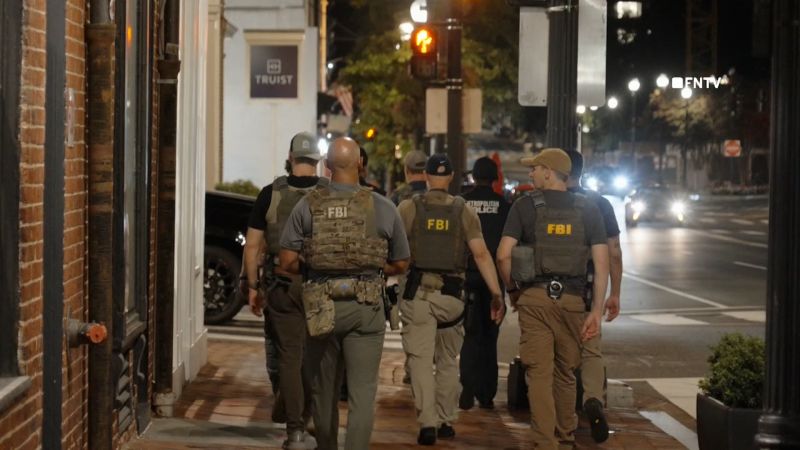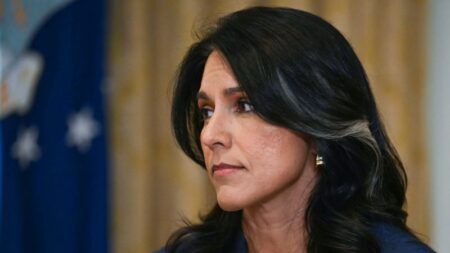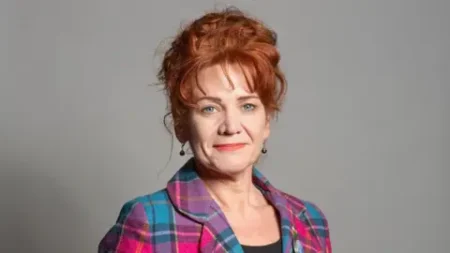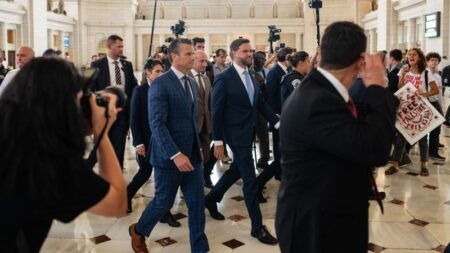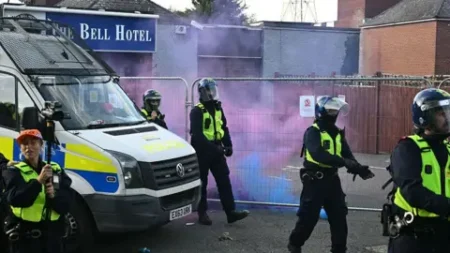On a particular Wednesday night in Washington, DC, a traffic checkpoint established by both local police and federal agents incited considerable community anger. This situation arose during the third night of President Donald Trump’s assertive control over the city’s police force. The citizens’ discontent was palpable as numerous vehicles were temporarily halted, with at least one individual being handcuffed and taken away by law enforcement at a checkpoint situated along the bustling 14th Street corridor, which is well known for its nightlife, featuring a multitude of bars and restaurants.
As the event unfolded, members of the local community gathered on both sides of the street, voicing their outrage vocally and persistently. For approximately two hours, individuals protested by chanting phrases such as “Shame,” “You are the criminals,” and “Get the f**k out of here,” effectively expressing their discontent with the presence of law enforcement. Some demonstrators also directed shouts at the federal agents, urging them to “Take off your mask!” as several of them were obscured.
Amidst this unrest, President Trump indicated his intentions to extend the federalization of the DC police force beyond the initial 30-day period, confidently expressing that he believed Congress, particularly the Republican members, would support his approach to tackle crime in the district. At an event held at the Kennedy Center, Trump stated, “If it’s a national emergency, we can do it without Congress, but we expect to be — before Congress very quickly…” asserting that he thought Democrats wouldn’t take adequate steps against crime, while Republicans would almost unanimously support his measures.
Interestingly, despite the intense atmosphere, the crowd managed to keep the protest peaceful, adhering to the sidewalks without crossing the line into physical confrontation with law enforcement. It was notable that the checkpoint involved not only the DC police but also agents from Homeland Security Investigations, a subsection of the Department of Homeland Security, and representatives from ICE’s Enforcement and Removal Operations. However, at that immediate time, there was no visible presence from the National Guard.
A DC police commander, preferring to remain anonymous and off-camera, described the checkpoint as a “routine” operation that the Metropolitan Police Department typically conducts in that area. This characterization was met with skepticism from local residents, one of whom noted, “We never have seen this,” reflecting on her 17 years of living in the neighborhood. She remarked that even during the most troubled times of Covid, such heavy law enforcement measures did not occur.
Local resident Mara Lasko, who actively waved a sign saying “ICE” to caution motorists about the checkpoint, articulated her disbelief: “I’ve lived in DC for 15 years, and, like, I’ve seen them stop people before but not like this. This is crazy.” When asked whether she believed the increased federal law enforcement presence would enhance safety, she responded negatively, stating that it only incited more anger among the residents.
On a broader scale, a White House official shared that a significantly increased presence of the National Guard was anticipated, transitioning from a nighttime role to a 24/7 operational status. However, as of the midnight transition into Thursday, there was no apparent augmented presence of National Guard troops in major city areas. The National Guard, a branch of the U.S. military, made its initial appearance in the capital on a preceding Tuesday, employing five armored personnel carriers situated near the Washington Monument.
CNN reported that by Wednesday evening, the National Guard had yet to be armed; however, this could change based on future directives. The involvement of the National Guard was primarily aligned with providing logistical support and backing law enforcement efforts instead of directly enforcing arrests. It was emphasized that the National Guard was not intended to perform arrests, but rather to contribute to creating a secure environment for other police officers.
The overarching context of the situation was Trump’s announcement earlier that week regarding his takeover of the city’s police structure. The motivation behind this decision was tied to elevated crime rates, though statistics indicated a decrease in violent crimes in the district over the two years leading up to his claim, which had peaked in 2023. Following the establishment of a new task force that included federal agents and local law enforcement, the White House documented 43 arrests on a certain Tuesday night as a result of this federal initiative.
As the city struggled with shifts in safety measures and public sentiment, DC Mayor Muriel Bowser voiced the necessity to ensure that the federal law enforcement surge served a legitimate purpose for the community. She encouraged residents to remain safe while continuing to exercise their democratic rights. The tension in the air was palpable as citizens navigated their feelings of concern, safety, and the need for expression during these complex times.
Overall, the situation in Washington, DC, epitomized the interplay between federal authority and local community sentiments, revealing the challenges and ramifications that arise during significant changes in law enforcement procedures and strategies.





